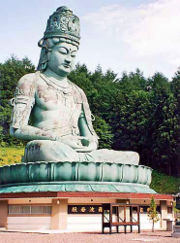
East Asian Buddhism
Encyclopedia

Mahayana
Mahāyāna is one of the two main existing branches of Buddhism and a term for classification of Buddhist philosophies and practice...
Buddhism
Buddhism
Buddhism is a religion and philosophy encompassing a variety of traditions, beliefs and practices, largely based on teachings attributed to Siddhartha Gautama, commonly known as the Buddha . The Buddha lived and taught in the northeastern Indian subcontinent some time between the 6th and 4th...
that developed in the East Asia
East Asia
East Asia or Eastern Asia is a subregion of Asia that can be defined in either geographical or cultural terms...
n region and follow the Chinese Buddhist canon
Chinese Buddhist canon
The Chinese Buddhist Canon refers to the total body of Buddhist literature deemed canonical in Chinese, Japanese, Korean, and Vietnamese Buddhism...
. These include Chinese Buddhism, Korean Buddhism
Korean Buddhism
Korean Buddhism is distinguished from other forms of Buddhism by its attempt to resolve what it sees as inconsistencies in Mahayana Buddhism. Early Korean monks believed that the traditions they received from foreign countries were internally inconsistent. To address this, they developed a new...
, Japanese Buddhism, and Vietnamese Buddhism.
Although a minority of East Asian Buddhists identify solely with that religion, others simultaneously practice Taoism
Taoism
Taoism refers to a philosophical or religious tradition in which the basic concept is to establish harmony with the Tao , which is the mechanism of everything that exists...
or the Chinese folk religion
Chinese folk religion
Chinese folk religion or Shenism , which is a term of considerable debate, are labels used to describe the collection of ethnic religious traditions which have been a main belief system in China and among Han Chinese ethnic groups for most of the civilization's history until today...
(in the case of ethnic Chinese); Shinto
Shinto
or Shintoism, also kami-no-michi, is the indigenous spirituality of Japan and the Japanese people. It is a set of practices, to be carried out diligently, to establish a connection between present day Japan and its ancient past. Shinto practices were first recorded and codified in the written...
(for Japanese); or Korean shamanism
Korean shamanism
Korean shamanism, today known as Muism or sometimes Sinism , encompasses a variety of indigenous religious beliefs and practices of the Korean people and the Korean area...
(for Koreans). Most East Asian cultures also incline towards Confucianism
Confucianism
Confucianism is a Chinese ethical and philosophical system developed from the teachings of the Chinese philosopher Confucius . Confucianism originated as an "ethical-sociopolitical teaching" during the Spring and Autumn Period, but later developed metaphysical and cosmological elements in the Han...
, which is not usually considered by its adherents to be a religion. Certain syncretic
Syncretism
Syncretism is the combining of different beliefs, often while melding practices of various schools of thought. The term means "combining", but see below for the origin of the word...
religions have arisen in East Asia which claim to harmonize Buddhism with other religions; among them are I-Kuan Tao
I-Kuan Tao
I-Kuan Tao, also Yīguàn Dào, or usually initialized as IKT is a new religious movement that originated in twentieth-century China. It incorporates elements from Confucianism, Taoism, and Chinese Buddhism, and recognizes the validity of non-Chinese religious traditions such as Christianity and...
(Taiwan), Caodaism (Vietnam); Chondogyo (Korea), and Oomoto
Oomoto
Oomoto also known as Oomoto-kyo , is a sect, often categorised as a new Japanese religion originated from Shinto; it was founded in 1892 by Deguchi Nao...
(Japan).
Major "schools" of East Asian Buddhism include Pure Land Buddhism
Pure Land Buddhism
Pure Land Buddhism , also referred to as Amidism in English, is a broad branch of Mahāyāna Buddhism and currently one of the most popular traditions of Buddhism in East Asia. Pure Land is a branch of Buddhism focused on Amitābha Buddha...
, Tientai, Huayen, and Chan Buddhism (Zen
Zen
Zen is a school of Mahāyāna Buddhism founded by the Buddhist monk Bodhidharma. The word Zen is from the Japanese pronunciation of the Chinese word Chán , which in turn is derived from the Sanskrit word dhyāna, which can be approximately translated as "meditation" or "meditative state."Zen...
). These are distinguished primarily on the basis of which sutras are considered most definitive (in contrast with the situation in Tibetan Buddhism, where the focus is on commentarial literature). Vajrayana
Vajrayana
Vajrayāna Buddhism is also known as Tantric Buddhism, Tantrayāna, Mantrayāna, Secret Mantra, Esoteric Buddhism and the Diamond Vehicle...
Buddhism also exists in East Asian forms, such as Japan's Shingon sect.
East Asian sangha members generally follow the Dharmaguptaka
Dharmaguptaka
The Dharmaguptaka are one of the eighteen or twenty early Buddhist schools, depending on one's source. They are said to have originated from another sect, the Mahīśāsakas...
Vinaya
Vinaya
The Vinaya is the regulatory framework for the Buddhist monastic community, or sangha, based in the canonical texts called Vinaya Pitaka. The teachings of the Buddha, or Buddhadharma can be divided into two broad categories: 'Dharma' or doctrine, and 'Vinaya', or discipline...
. The major exception is Japan, where monks (now called "priests" in English) received imperial permission to marry during the Meiji Restoration
Meiji Restoration
The , also known as the Meiji Ishin, Revolution, Reform or Renewal, was a chain of events that restored imperial rule to Japan in 1868...
, and thus no longer follow any traditional monastic code.

